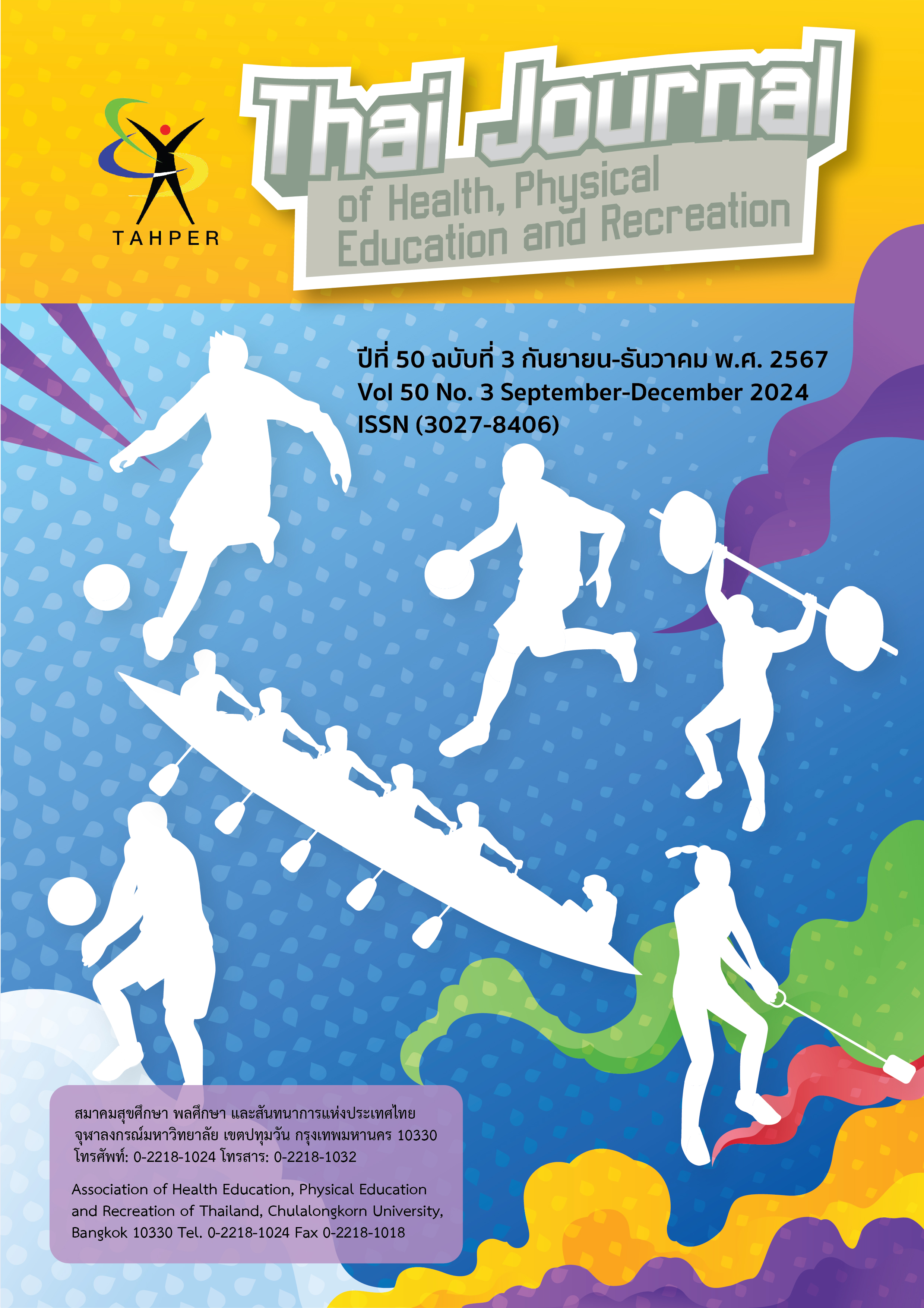การวิเคราะห์รูปแบบของกลยุทธ์ที่มีผลต่อการทำคะแนนในขณะแข่งขันวอลเลย์บอล ชายและหญิงระดับลีกอาชีพของประเทศไทย
Main Article Content
บทคัดย่อ
การวิจัยครั้งนี้มีวัตถุประสงค์เพื่อศึกษาและเปรียบเทียบรูปแบบของกลยุทธ์ที่มีผลต่อการทำคะแนนในขณะแข่งขันวอลเลย์บอลทีมชายและทีมหญิง กลุ่มตัวอย่างเป็นเทปบันทึกภาพการแข่งขันซีพี วอลเลย์บอล ไทยแลนด์ลีก 2020 รอบสุดท้าย ทั้งประเภททีมชายและประเภททีมหญิง โดยทำการวิเคราะห์เกมการแข่งขันทั้งหมด 24 เกมการแข่งขัน ได้มาจากการสุ่มแบบเฉพาะเจาะจง (Purposive sampling) โดยเทปบันทึกได้รับความยินยอมและอนุญาตจากทางสมาคมกีฬาวอลเลย์บอลแห่งประเทศไทย เก็บรวบรวมข้อมูลผ่านโปรแกรมวิเคราะห์การใช้ทักษะกีฬายี่ห้อ Dartfish เวอร์ชั่น 7 นำผลที่ได้มาทำการวิเคราะห์ข้อมูลทางสถิติโดยแสดงค่าความถี่และค่าร้อยละ โดยใช้สถิติไคสแควร์ (chi-square) และหาค่าสัมประสิทธิ์สหสัมพันธ์ของเพียร์สัน (Pearson-Product Moment Correlation Coefficient) โดยกำหนดนัยสำคัญทางสถิติที่ระดับ 0.05 ผลการวิจัยพบว่า เมื่อเปรียบเทียบรูปแบบของกลยุทธ์ที่มีผลต่อการทำคะแนนในขณะแข่งขันระหว่างนักกีฬาวอลเลย์บอลทีมชายและทีมหญิงพบว่าไม่มีความแตกต่างกัน โดยนักกีฬาวอลเลย์บอลทีมชายได้คะแนนจากข้อผิดพลาดของคู่แข่งขัน 56 เปอร์เซ็นต์ และนักกีฬาวอลเลย์บอลทีมหญิงได้คะแนนจากข้อผิดพลาดของคู่แข่งขัน 53.3 เปอร์เซ็นต์ แต่เมื่อเปรียบเทียบการได้คะแนนจากข้อผิดพลาดของคู่แข่งขันระหว่างนักกีฬาวอลเลย์บอลชายและหญิง พบว่า มีความแตกต่างกันอย่างมีนัยสำคัญทางสถิติที่ระดับ 0.05 โดยนักกีฬาวอลเลย์บอลชายได้คะแนนจากข้อผิดพลาดของการสกัดกั้น 351 คะแนน 32.2 เปอร์เซ็นต์และนักกีฬาวอลเลย์บอลหญิงได้คะแนนจากข้อผิดพลาดของรับบอลตบและบอลเสิร์ฟ 337 คะแนน 33 เปอร์เซ็นต์ข้อมูลรูปแบบของกลยุทธ์ที่มีผลต่อการทำคะแนนจากการวิจัยนี้ จะเป็นแหล่งข้อมูลที่สำคัญที่จะไปใช้ในการจัดโปรแกรมการฝึกซ้อมให้สอดคล้องกับลักษณะรูปแบบของกลยุทธ์ที่มีผลต่อการทำคะแนนการเล่นที่เกิดขึ้นจากการแข่งขันในสถานการณ์ของวอลเลย์บอลชายและหญิงจริงต่อไป
Article Details

This work is licensed under a Creative Commons Attribution-NonCommercial-NoDerivatives 4.0 International License.
ความคิด ข้อวิพากษ์ในวารสารเป้นสิทธิของผู้เขียน สมาคมสุขศึกษา พลศึกษา และสันทนาการแห่งประเทศไทยไม่จำเป็นต้องเห็นชอบด้วยเสมอไป เพื่อให้เกิดความหลากหลายในความคิดและความสร้างสรรค์
References
กรมพลศึกษา. (2555). คู่มือผู้ฝึกสอนกีฬาวอลเลย์บอล T-Certificate สำนักงานกิจการโรงพิมพ์องค์การสงเคราะห์ทหารผ่านศึก ในพระบรมราชูปถัมภ์. กรุงเทพฯ.
กฤตยา ศุภมิตร. (2556). การศึกษาเปรียบเทียบกลยุทธ์การตบในกีฬาวอลเลย์บอลหญิงของทีมที่ประสบความสำเร็จกับทีมที่ไม่ประสบความสำเร็จในการแข่งขันโอลิมปิกเกมส์ 2012. จุฬาลงกรณ์มหาวิทยาลัย.
กองกีฬา กรมพลศึกษา. (2535). คู่มือการเล่นวอลเลย์บอล. กรุงเทพมหานคร: ห้างหุ้นส่วนจำกัดไอเดียสแควร์.
Araújo, D., Travassos, B., & Vilar, L. (2010). Tactical skills are not verbal skills: a comment on Kannekens and colleagues. Perceptual and motor skills, 110 (3_suppl), 1086-1088 %@ 0031-5125.
Araújo, R., Mesquita, I., & Marcelino, R. (2009). Relationship between block constraints and set outcome in elite male volleyball. International Journal of Performance Analysis in Sport, 9(3), 306-313.
Conejero, M., Claver, F., González-Silva, J., Fernández-Echeverría, C., & Moreno, P. (2017). Analysis of performance in game actions in volleyball, according to the classification. Revista Portuguesa de Ciências do Desporto, 1645-0523.
Cornelius, H. R. (2016). Match Analysis of a Women's Volleyball Championship Game.
Costa, G., Afonso, J., Brant, E., & Mesquita, I. (2012). Differences in game patterns between male and female youth volleyball. Kinesiology, 44(1), 1331-1441.
Costa, G. C., Caetano, R. C. J., Ferreira, N. N., Junqueira, G., Afonso, J., Costa, R. D. P., & Mesquita, I. (2011). Determinants of attack tactics in youth male elite volleyball. International Journal of Performance Analysis in Sport, 11(1), 2474-8668.
Franks, I. M., & Miller, G. (1986). Eyewitness testimony in sport. Journal of sport behavior, 9(1), 0162-7341.
González-Silva, J., Fernández-Echeverría, C., Conejero, M., & Moreno, M. P. (2020). Characteristics of Serve, Reception and Set That Determine the Setting Efficacy in Men’s Volleyball. Frontiers in Psychology, 11.
Häyrinen, M., Hoivala, T., & Blomqvist, M. (2004). Differences between winning and losing teams in men’s European top-level volleyball.
JoãTo, P. V., Leite, N., Mesquita, I., & Sampaio, J. (2010). Sex differences in discriminative power of volleyball game-related statistics. Perceptual and motor skills, 111(3), 893-900.
Marelić, N., Rešetar, T., & Janković, V. (2004). Discriminant analysis of the sets won and the sets lost by one team in A1 Italian volleyball league-A case study. Kinesiology, 36(1), 75-82.
Martín-Matillas, M., Valadés, D., Hernández-Hernández, E., Olea-Serrano, F., Sjöström, M., Delgado-FernáNdez, M., & Ortega, F. B. (2014). Anthropometric, body composition and somatotype characteristics of elite female volleyball players from the highest Spanish league. Journal of sports sciences, 32(2), 137-148.
McGarry, T., O'Donoghue, P., Sampaio, J., & de Eira Sampaio, A. J. (2013). Routledge handbook of sports performance analysis: Routledge.
Palao, J. M., & Martínez, S. (2013). Use of jump set in relationship to the competition level in male volleyball. SporTK, 1(2), 43-49.
Palao, J. M., Santos, J. A., & Ureña, A. (2004). Effect of the type and effectiveness of the serve on the blocking and the performance of the defensive team. Sports performance. com, 8.
Rabaz, F. C., Castuera, R. J., Arias, A. G., DomÍGuez, A. M., & Arroyo, M. P. M. (2013). Relationship between performance in game actions and the match result. A study in volleyball training stages. Journal of Human Sport and Exercise, 8(3), S651-S659.
Silva, M., Lacerda, D., & João, P. V. (2014). Game-related volleyball skills that influence victory. Journal of human kinetics, 41(1), 173-179.
Stanković, M., Ruiz-Llamas, G., & Quiroga-Escudero, M. E. (2017). Effects of tested rules on work-rest time in volleyball. Motricidade, 13(3), 13-21.
Suárez, M. C., Rabaz, F. C., Fernández-Echeverría, C., Gil-Arias, A., & Arroyo, M. P. M. (2017). Relationship between decision-making and performance in game actions in volleyball. RETOS. Nuevas Tendencias en Educación Física, Deporte y Recreación 31, 28-33.
Zetou, E., Moustakidis, A., Tsigilis, N., & Komninakidou, A. (2007). Does effectiveness of skill in Complex I predict win in men's Olympic volleyball games? Journal of Quantitative analysis in Sports, 3(4).

